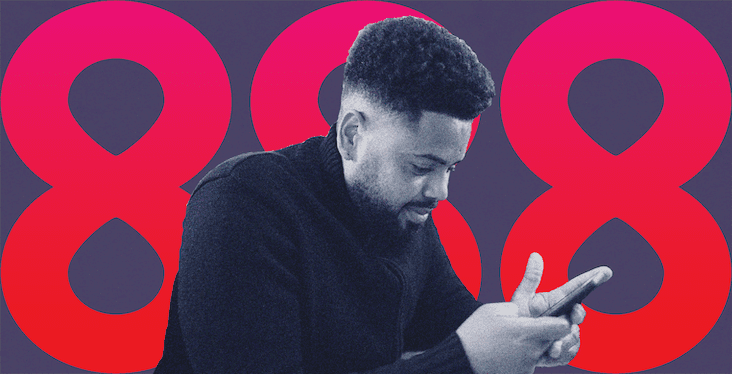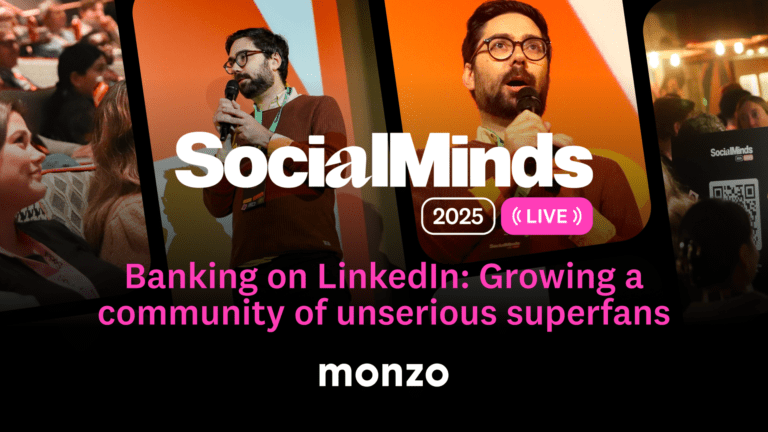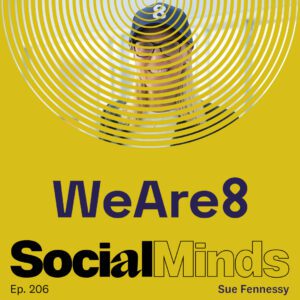Sustainable social platform WeAre8 wants your brand to join the “new world” of responsible advertising
Up and coming social media platforms have their work cut out for them. In the face of big tech’s monopoly on our most used social apps, achieving mainstream success isn’t easy. TikTok, for example, is the only upstart to take on the key players and win. And despite BeReal’s moment in the spotlight, it doesn’t even scratch the top 10 downloaded apps this year.
But WeAre8 wants to change that. Founded by tech entrepreneur Sue Fennessy, WeAre8 markets itself as a sustainable social media platform that benefits all: users, brands, advertisers and the environment. It almost sounds like the perfect social media platform, but does such a thing exist? Sue joined the Social Minds podcast to tell us more.

To break into the competitive market, a new social platform must truly rock the boat. WeAre8 not only gives back to users, but hopes to revolutionise the way we use social. Unlike its competitors, WeAre8 ads are optional. Users give feedback to brands after viewing the ad and are paid for their trouble – not in loyalty points or tokens, but in real money.
Ads are separate from the feed experience, which consists of two main elements. The 8Stage is a curated feed for users to get inspired by brands and creators, with a focus on authenticity and positivity. And the newly launched Friends Feed is an algorithm-free throwback to the likes of Facebook and Instagram in their earliest stages: it’s a feed solely dedicated to content posted by family and friends.
Mark Zuckerberg once said platforms shouldn’t be “the arbiter of truth”, but Sue argues this stance absolves them of their civic responsibility. WeAre8 isn’t shy to align itself with social and environmental causes, and the app doesn’t allow political advertising, climate misinformation or ‘greenwashing’ ads from oil companies. The company also invests 1% of a brand’s media budget into climate and community projects for every campaign run on WeAre8.
“People don’t want to watch disruptive ads. It’s only when they feel valued that they’re happy to consume.”
Moreover, over half of its revenue goes back into stakeholders’ wallets. Of every dollar, 50% goes to citizens, 5% goes to charity and 5% is invested into its own creator fund. All of this leaves brands with a big question: what’s in it for me?
“Today’s advertising system is incredibly wasteful, not only for advertisers’ resources but for the environment too,” Sue explains. “People don’t want to watch disruptive ads. It’s only when they feel valued that they’re happy to consume.”

Sue has a point. The average engagement rate for an ad on Facebook is under 1%. And Google found that over 56% of ad impressions are never seen by consumers despite an average viewability rate of 50%. It’s not an understatement to say digital marketers are misspending millions of dollars every year.
By serving ads only to willing users, WeAre8 guarantees an engagement rate 10 times that of Facebook for every brand campaign on the platform. Nike, Heineken and the Fairtrade Foundation have all seen success in this respect. In fact, Nike received over 280k responses – not likes or views, actual written replies – to a question posed at the end of its mental health awareness ad campaign.
“Advertising isn’t going anywhere, so the least we can do is advertise responsibly.”
And what about brand safety? It’s an issue at the forefront of any marketer’s mind after Twitter’s recent chaos. With misinformation producing very real negative consequences for brands (US pharmaceutical firm Eli Lilly lost billions in market cap thanks to a misleading Twitter parody account), it’s vital that social platforms have robust policies to protect brand reputation.
“You can’t be anonymous on WeAre8,” Sue says. “Profiles are connected to your personal details. We have a zero-tolerance policy on hate speech. If you post something abusive, you’re off the platform.” Content is moderated both manually and using an AI model built at scale for profiles, posts, and comments. There’s community reporting too.

For all its benefits, it’s clear social media has a dark side – a side that fuels division, enables harassment, and perpetuates comparison culture. And its use has a hefty carbon footprint, with one person producing 140 kg of carbon emissions if they spend 145 minutes on TikTok daily for one year, according to data from Global Citizen. Plus, as brands compete for attention in today’s pay-to-play landscape, advertisers need bigger budgets to get more value for money.
But attempting to kill several birds with one stone is no mean feat, and it’s tough to call whether WeAre8 will win where similar startups like Gerner8 Ads and GoodLoop have struggled to gain mass adoption.
The lure of high engagement, better ad recall and view-through rates is certainly a selling point. But as with any other social platform, ads must be considered as part of a cross-channel strategy. Here the opportunity is in corporate social responsibility initiatives, and in particular, WeAre8 is a natural partner for ethical and eco-conscious brands.
And remember the viral meme that wanted to “make Instagram Instagram again”? It has two million likes and the corresponding petition has racked up over 320k signatures. Where recommended content in social feeds can only increase with time, WeAre8’s Friends Feed caters to those who want to use social media to check in with their personal connections. Then again, Instagram served that purpose once – until it didn’t.
Admittedly, mass adoption can call a lot of things into question. On the face of it, WeAre8 is committed to building a safe environment for users. But as more people flock to the platform, its content moderation will truly be put to the test.
If it’s a good fit for your brand, it’s worth considering -but the jury’s still out on whether WeAre8’s advertising solution is a sustainable one. It’s a beautiful dream, but will it become a reality? We’ll have to wait and see.





